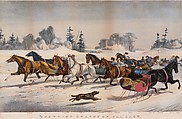"Trotting Cracks" on the Snow
Louis Maurer American, born Germany
Publisher Currier & Ives American
Not on view
Nathaniel Currier, and his partner James Ives, produced over 7,000 different lithographs, including almost 700 trotting horse scenes for an avid racing public who wanted inexpensive pictures of their trotting heroes. Many of these equestrian subjects were created by Louis Maurer, the artist who produced numerous popular lithographs for the firm between 1853 and 1893. In this charming wintry country scene with trees lining the horizon, one- and two-horse sleighs pulled by noted trotters race from right to left along a snow-covered road. The lead horse is identified as Pocohontas; all the other racing horses are identified by name in the key imprinted beneath the image. At center, a black dog chases after a gold-trimmed red sleigh going in the opposite direction.
Currier, whose successful New York-based lithography firm began in 1835, produced thousands of hand-colored prints in various sizes that together create a vivid panorama of mid-to-late nineteenth century American life and its history. People eagerly acquired such lithographs featuring picturesque scenery, rural and city views, ships, railroads, portraits, hunting and fishing scenes, domestic life and numerous other subjects, as an inexpensive way to decorate their homes or business establishments. As the firm expanded, Nathaniel included his younger brother Charles in the business. In 1857, James Merritt Ives (the firm's accountant since 1852 and Charles's brother-in-law) was made a business partner; subsequently renamed Currier & Ives, the firm, which became known as "the printmakers to the American people," continued until 1907.
This image cannot be enlarged, viewed at full screen, or downloaded.


